What Can You Feed an Injured Canadian Goose
What Do Geese Eat? A Guide to Feeding Geese
-
By: Tim Daniels
- November 11, 2008
- Updated: 1 year ago
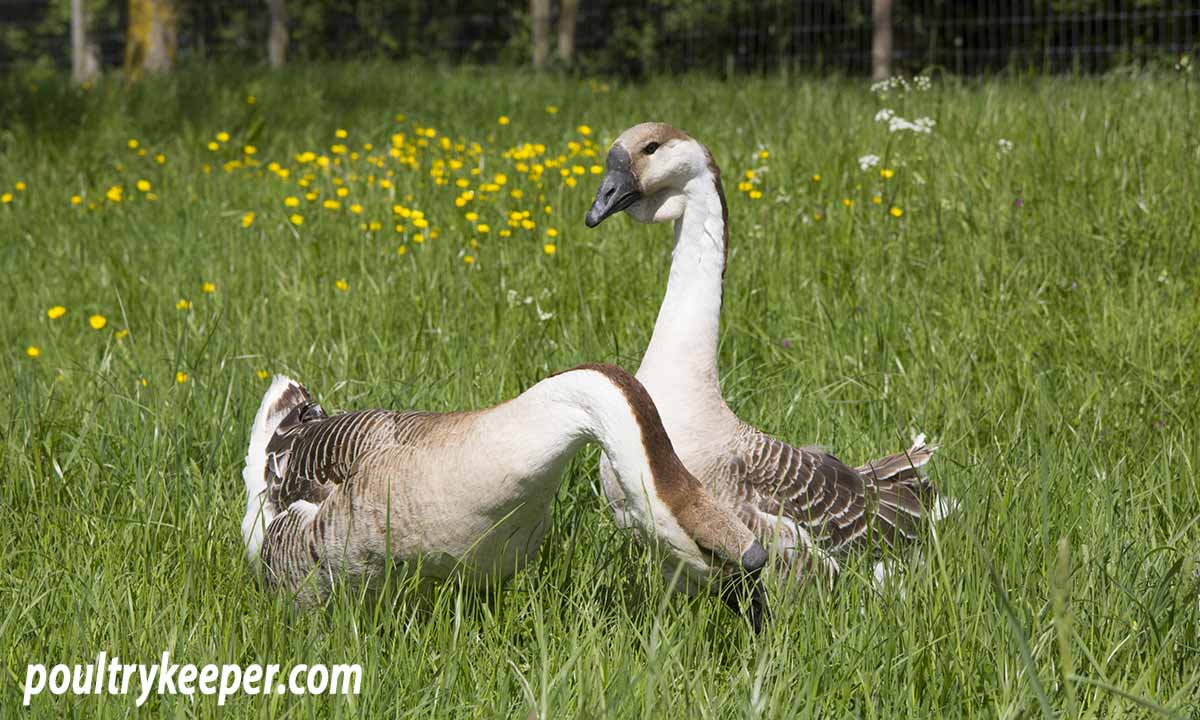
What do geese eat? In this guide, I look at what geese eat in the wild and then provide some tips on what to feed geese on your local pond and what to feed domestic goose breeds, kept at home. In short, everything you need to know about feeding geese!
Geese will mainly feed on grass if there is enough of it and if it has sufficient quality. Grass contains all of the vitamins and minerals geese need but only has this nutrition when it is fresh in the spring. Grass needs to be short, (about 8cm or 3 inches), which can mean frequent mowing at home for our domestic geese, or keeping them within a mixed farm system with larger animals that will graze the longer grasses first.
What do geese eat when the nutrient levels in grass fall away or at times when there isn't much grass available? Well, wild geese have the ability to fly to find other foods and you will often see geese feeding on fields, village greens, rivers, lakes or ponds to forage for a variety of foods.
What do geese eat?
Wild geese spend about half of their day feeding on land and water.
A goose's diet consists of various grasses, clover, alfalfa, seed heads, wheat, maize, barley and beans from fields (usually foraged from fields after harvesting). They will eat a few berries from hedgerows from time to time when they are available, although they usually prefer to be in an open area, so they can see predators coming. Geese will eat several aquatic plants, especially sedges and their seed heads, and pull submerged roots and rhizomes out of the silt to eat. Although geese eat insects, this doesn't make up much of their diet.
Wild geese will increase their food consumption before they migrate, so they can build up reserves before embarking on a long flight. During the autumn and into winter, they also increase carbohydrate consumption (grains and berries) so they can produce more heat to keep warm.
Wild geese have to range further when food is scarce during the harsh winter months and here in the UK, geese will often move further south when the winter is particularly cold.
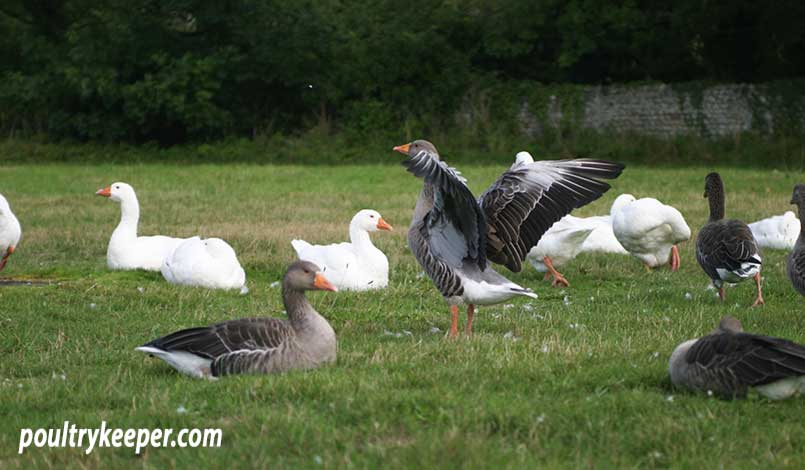
What to feed geese on your local pond
Many people enjoy going to parks to feed ducks and geese, and they soon get used to being fed. There are, unfortunately, a lot of people feeding the wrong food to waterfowl.
What to feed geese? Bread is a favourite; however, it doesn't have any nutritional value. They soon fill up on bread, leaving other foods they would naturally eat. Eventually they end up malnourished.
Sadly, more and more geese arrive for the food handouts until the pond cannot support their numbers, so there is little natural food available. They stop teaching their young to forage locally and eventually, they become completely reliant on us to feed them.
If you are going to feed wild geese, choose nutritious foods such as sweet corn and peas (either tinned or frozen, just defrost them in warm water first), and greens such as cabbage, cauliflower leaves or lettuce. Ideally some wheat or mixed corn which is readily available for chickens.
Feeding domestic geese
Unless you are fortunate enough to have a paddock, orchard or similar with about a half-acre of grass for them to graze, then you might ask if it is fair to keep domestic geese. It can also be challenging to make orchards, lawns and fields fox-proof since domestic geese cannot fly away to safety. Even with a pond or lake, geese don't always take to the water when startled, and they are not always near the water's edge when feeding.
We know that geese love grass so, feeding geese means providing them with an area they can graze; however, the nutrients vary considerably according to the type of grass, the length and the time of year. Domestic breeds of geese, kept by poultry keepers like myself, are larger than wild geese and, being confined, cannot range as far, so when feeding geese at home, we need other foods to supplement their diet.
Domestic geese are alsoheavier than their wild cousins. Many goose breeds were bred to have a good size for the table; just a few, like the Chinese goose, were lighter and bred to produce eggs so, none of the domestic breeds can fly because they are too heavy for flight.
At least, if they can fly, they can't fly very far! My Brecon Buff geese can sometimes 'take off' while running downhill or when the wind blows in a favourable direction, but they land after a few seconds of flight.
Wheat
Domestic geese can be fed mainly on grass during the spring and early part of summer if you have enough of it available and can keep it cut short. In addition to this, or if you run out of good clean grass, you can feed wheat in the bottom of a bucket of water. The wheat will sink to the bottom.
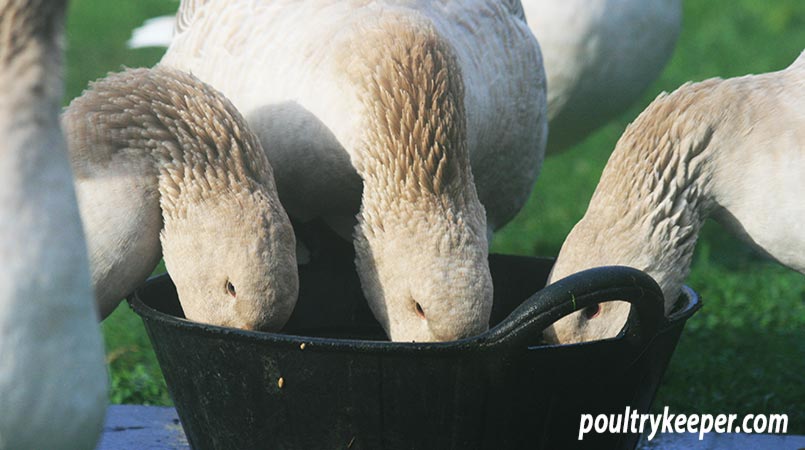
Without grass, a medium-size goose will eat around200g of food per day.
I provide my geese with ad-lib wheat in a half-sized bucket, and their layers pellets are available ad-lib in a hopper so that they can take what they want of both.
Providing wheat in water has the advantage of keeping it away from crows, rats and mice, although remember rats need to be near a source of water as well as food, so if you see evidence of rats, always remove both food and water overnight.
What do geese eat that we can provide to them? Well, geese love greens such as cabbage, cauliflower leaves and lettuce. They will also eat leftover vegetables like cooked potatoes, carrots, parsnips etc., although not all geese like the same things, they usually have to get a taste for it so you might need to give them some time and try different foods until you find what they like.
Generally, it is best to provide a little food for geese to take should they want it for breakfast or before bed.
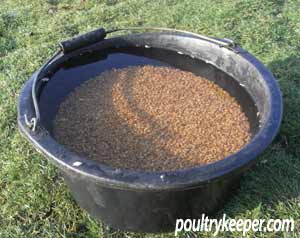
When the grass is growing well during the spring and summer months, this is rarely needed. Domestic geese should be given wheat and dried poultry layers pellets mixed in equal quantities but not layers mash/crumble (because this can get stuck in their mouths).
Geese will normally lay a few more eggs when fed on wheat and pellets; however, they must not be allowed to get too fat. Scraps such as bread should be regarded as treats and fed only in small quantities. Bread is not a natural food for domestic ducks and geese; it provides them with no nutrients, so generally is not good as a feed for domestic waterfowl but can be given as a treat, now and again.
Domestic geese should always be offered layers pellets during the breeding season to provide calcium but remember, layers pellets will soon go bad if they get wet, so only feed what they will eat in a breakfast or bedtime meal if you don't use a waterproof hopper.
Grass control with geese
Keeping a few geese as environmentally friendly 'lawn mowers' can be useful for grass control. When a suitable area of grass is available, including some shaded areas, you can graze your flock of geese there, providing there is no problem with predators, such as foxes.
Geese are sometimes used in organic farming systems to clear fields of broadleaf weeds and perennial grasses. Geese have fantastic characters, and unlike ducks, they do not wander far. Once trained to stay in a particular area, they will usually stay put and focus on the task at hand!
Grass ideally needs to be kept short and fresh for geese, but if there is a big enough area, they will find shorter grass between the long strands. It's usually a good idea to provide them with some shorter cut areas too, but depending on where you live, cutting the grass short might mean it will go brown and die off during the warmer weather, so it's best to use your own judgement and some trial and error.

As well as eating grass, your geese will enjoy seed heads of long grasses and weeds from time to time.
Geese can add a security element to the vicinity, making a lot of noise when something unfamiliar comes near, alerting you to visitors or predators nearby.
Managing wildflower meadows and orchards with geese
If you have a meadow or orchard that hasn't had any artificial fertilisers or chemicals added to it for the last ten years, and you have the right soil type, then there is a good chance you will be able to encourage wildflowers to thrive and keep your geese happy with grass for much of the year.
There are a few different ways to manage wildflower meadows, but geese can be used for grazing, to remove nutrients from the meadow, with the added benefit that they will graze broadleaf weeds and difficult perennial grasses that are normally difficult to discourage once they are established.
Between mid-February and the end of April, exclude geese from the meadow. Most wildflowers are emerging at this time and can be damaged easily. Once the grass is 5 or 6 inches high, the geese can be given access. The stocking density should be no more than two geese per acre. We only want to graze the meadow lightly.
Geese ideally need short, fresh grass, so if the grass grows tall, you may need to cut some areas for them to have some shorter grass.
In late August or early September, once the seeds have dropped from grasses and flowers,cut the meadow and remove the cuttings.It is imperative not to leave cuttings on the ground because this adds nutrients. Leave the geese in the meadow to graze the aftergrowth. If you have more geese, you can increase the stocking density to ensure any fresh autumn grass growth is eaten.

Once the grass stops growing and is only a few inches high,remove the geese until the following season. Leaving them on there will only add unnecessary nutrients from droppings.
Water
Water is essential, but not just for them to digest their food. Geese don't have tear ducts, so they need to be able to dip their heads underwater to clean their eyes and to flush out their nostrils and clean their beaks.
A tub of water for them to bathe in can also serve as drinking water. As long as it's deep enough for them to dip their heads under.
Poultry grit for geese
What do geese eat to digest their food? In the wild, geese will pick up small stones and grit and sand from the ground and from the bottom of the lake or river to help them digest their food. We need to provide sand (standard builders sand will do) plus mixed poultry grit containing flint grit and oyster shell for our domestic geese.
An easy way to do this is to bury a flowerpot in the ground and peg it down through the holes at the bottom. It can then be filled up with grit and should be free to drain during wet weather.
If you are unsure what the two different grit types are used for, then my article on poultry grit would be worth a read. Although it was written with chickens in mind, the same principles apply to geese (except they also need sand).
So now you know what to feed geese! I hope this guide has been useful, and as always, I welcome comments below.
Tim Daniels
Tim is the founder of the poultry keeper website and lives in Herefordshire, UK. He is passionate about poultry and keeps a range of different chickens, ducks, geese and quail.
All Posts »
Related Posts:
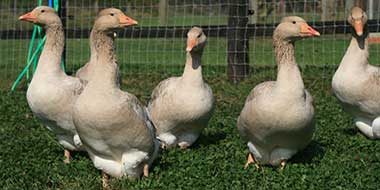
Keeping Geese
The Beginner's Guide to Keeping Geese
This beginners guide to keeping geese will take you, step by step, through the basics of keeping geese, whether you are wondering whether geese are the right choice for you or if you have already purchased your geese and want to learn more.
Read More »

Book Reviews
Keeping Ducks and Geese Book Review
Keeping Ducks and Geese by Chris and Mike Ashton certainly doesn't disappoint. Just like "Keeping Chickens", it is very well presented with excellent colour photos and diagrams and it is packed with useful information.
Read More »
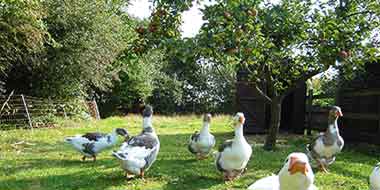
Keeping Geese
Creating an Orchard for Poultry
Traditionally, in Europe, people kept poultry in orchards. Chickens and waterfowl would eat insects and fallen fruit, and geese would keep the grass short. Droppings helped provide nutrients for the trees, and the trees provided shade, shelter and safety.
Read More »
Creating an Orchard for Poultry
Traditionally, in Europe, people kept poultry in orchards. Chickens and waterfowl would eat insects and fallen fruit, and geese would keep the grass short. Droppings helped provide nutrients for the trees, and the trees provided shade, shelter and safety.
Read More »
Keeping Ducks and Geese Book Review
Keeping Ducks and Geese by Chris and Mike Ashton certainly doesn't disappoint. Just like "Keeping Chickens", it is very well presented with excellent colour photos and diagrams and it is packed with useful information.
Read More »
The Beginner's Guide to Keeping Geese
This beginners guide to keeping geese will take you, step by step, through the basics of keeping geese, whether you are wondering whether geese are the right choice for you or if you have already purchased your geese and want to learn more.
Read More »
On this page:
You might also enjoy:

Keeping Geese
Creating an Orchard for Poultry
Traditionally, in Europe, people kept poultry in orchards. Chickens and waterfowl would eat insects and fallen fruit, and geese would keep the grass short. Droppings helped provide nutrients for the trees, and the trees provided shade, shelter and safety.
Read More »
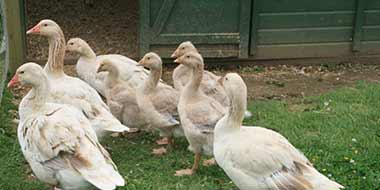
Keeping Geese
Housing Geese
Providing you can give sufficient space, adequate ventilation and security from nighttime predators, a goose house need not be complicated. In this article, Mo provides the low-down on housing geese.
Read More »

Keeping Geese
The Beginner's Guide to Keeping Geese
This beginners guide to keeping geese will take you, step by step, through the basics of keeping geese, whether you are wondering whether geese are the right choice for you or if you have already purchased your geese and want to learn more.
Read More »
Source: https://poultrykeeper.com/keeping-geese/feeding-geese/
0 Response to "What Can You Feed an Injured Canadian Goose"
Postar um comentário